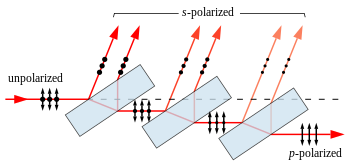偏振光(Polarization)与布儒斯特角(Brewster's angle)
Polarization is a property of transverse wave. Here we have some basics prepared for the Brewster's angle.
.svg/180px-Polarisation_(Linear).svg.png)
.svg/180px-Polarisation_(Circular).svg.png)
.svg/180px-Polarisation_(Elliptical).svg.png)
In the leftmost figure above, the two orthogonal (perpendicular) components are in phase. In this case the ratio of the strengths of the two components is constant, so the direction of the electric vector (the vector sum of these two components) is constant. Since the tip of the vector traces out a single line in the plane, this special case is called linear polarization. The direction of this line depends on the relative amplitudes of the two components.
In the middle figure, the two orthogonal components have exactly the same amplitude and are exactly ninety degrees out of phase. In this case one component is zero when the other component is at maximum or minimum amplitude. There are two possible phase relationships that satisfy this requirement: the x component can be ninety degrees ahead of the y component or it can be ninety degrees behind the y component. In this special case the electric vector traces out a circle in the plane, so this special case is called circular polarization. The direction the field rotates in depends on which of the two phase relationships exists. These cases are called right-hand circular polarization and left-hand circular polarization, depending on which way the electric vector rotates and the chosen convention.
Another case is when the two components are not in phase and either do not have the same amplitude or are not ninety degrees out of phase, though their phase offset and their amplitude ratio are constant. This kind of polarization is called elliptical polarization because the electric vector traces out an ellipse in the plane (the polarization ellipse). This is shown in the above figure on the right.
Most sources of electromagnetic radiation contain a large number of atoms or molecules that emit light. The orientation of the electric fields produced by these emitters may not be correlated, in which case the light is said to be unpolarized. If there is partial correlation between the emitters, the light is partially polarized. If the polarization is consistent across the spectrum of the source, partially polarized light can be described as a superposition of a completely unpolarized component, and a completely polarized one.
Brewster's angle (also known as the polarization angle) is an angle of incidence at which light with a particular polarization is perfectly transmitted through a transparent dielectric surface, with no reflection. When unpolarized light is incident at this angle, the light that is reflected from the surface is therefore perfectly polarized. This special angle of incidence is named after the Scottish physicist Sir David Brewster (1781–1868).

To be more quantitative, let's first have two defination:
1)If not taking substances which absorb as well as refract into consideration, we can have the index of refraction by $$n≡\frac{c}{v_{phase}}$$
where \(c\) is the speed of light and \(v_{phase}\) is the phase velocity.
2)A reflection coefficient describes the amplitude of a reflected wave relative to that of the incident wave.
The Fresnel equations can give the ratio of the reflected and transmitted electric field amplitude to initial electric field for electromagnetic radiation incident on a dielectric. In general, when a wave reaches a boundary between two different dielectric constants, part of the wave is reflected and part is transmitted, with the sum of the energies in these two waves equal to that of the original wave. Since electromagnetic waves are transverse, there are separate coefficients in the directions perpendicular to and parallel to the surface of the dielectric. The coefficients for reflection and transmission of the "transverse electric field" (abbreviated "TE") are denoted \(r_\perp\) and \(t_\perp\), respectively, while the coefficients for reflection and transmission of the "transverse magnetic field" (abbreviated "TM") are denoted \(r_\parallel\) and \(t_\parallel\), respectively. In this formulation, a negative sign for an amplitude coefficient denotes a ray in the opposite direction as the incident ray. Knowing all that, when we look at this,

it's evident that if \(r_\parallel=0\), we would have a polarised reflect ray, which basically is saying \(n_1=n_2\) or
$$n_2cos\theta_1=n_1cos\theta_2$$
$$\Rightarrow cos^2\theta_2=(\frac{n_2cos\theta_1}{n_1})^2$$

Also, we have the Snell's Law,$$n_1sin\theta_1=n_2sin\theta_2$$
$$\Rightarrow sin^2\theta_2=(\frac{n_1sin\theta_1}{n_2})^2$$
Solve the above equations,$$tan^2\theta_1=\frac{n_2^2}{n_1^2}$$
$$\Rightarrow\theta_1=arctan\frac{n_2}{n_1}$$
Well \(\theta_1\) is the Brewster's angle, AKA,\(\theta_B\).
Evidently, should we push further, \(\theta_1+\theta_2=\pi/2\), as showed below.

Now let's consider a polarizer made out of what we have been nagging about. As usual, first some definations. When we mentioned the plane, mostly we refer to the plane of incidence. And light polarized in the plane is said to be p-polarized, while perpendicular s-polarized. In our case of Brewster's angle, apparently all reflected light is s-polarized. Note that though the ray of reflection is perfectly polarized, the refraction ray isn't so polarized as we hope. Thus one may tilt a stack of plates, each depleting the incident beam of s-polarized light, to leave greater fraction of p-polarized at each stage, as following pic:

For visible light in air and typical glass, Brewster's angle is about 57°, and about 16% of the s-polarized light present in the beam is reflected for each air-to-glass or glass-to-air transition. It takes many plates to achieve even mediocre polarization of the transmitted beam with this approach. For a stack of 10 plates (20 reflections), about \(3% (= (1-0.16)^20)\) of the s-polarized light is transmitted. The reflected beam, while fully polarized, is spread out and may not be very useful.

